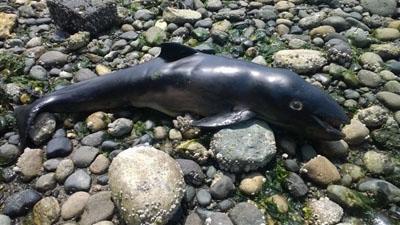
Porpoise Pathos

At Chez VHP the other day, we heard loud bleating through an open window. We popped outside to ascertain who the unhappy camper was. A few feet from shore, a newborn Harbor Seal pup paddled frantically and yowled for Mom. Mama was away from Baby, and l’enfant did not like that at all. Fortunately, Mother Seal responded promptly to her needy youngster – crisis averted.
This is our busy season for marine mammal stranding response. We had a few cases of note in July. On July 11, an Islander left a message about a “dead baby orca” on a remote west side beach. The caller described the small body as all black, so I reckoned that the mystery critter was likely a porpoise, not an orca. Nevertheless, any cetacean carcass in decent condition is of high priority and of great worth to researchers. Dear readers, call us immediately when you come upon stranded cetaceans – whales, dolphins, or porpoises.
Alas, the tide was in and quite high, so we were unable to retrieve the body on the 11th. That perturbed me. Finding a stranded newborn is a rarity. Would the valuable specimen drift out of range on the Colvos Pass currents? To my relief, Julie called on July 13: the porpoise had washed ashore at Sunset Beach. She emailed useful photos, as well.
Just as the tide threatened to reclaim our “baby,” Odin and I recovered the newborn Harbor Porpoise from the beach. Emaciated, slightly scavenged, and streaked with fetal folds, the frail male neonate was a pitiful sight. He had no teeth – porpoise calf teeth grow in during the first year. Two curly whiskers protruded from his tiny snout. Look closely at this week’s photo to see the fetal folds and the toothless gums.
Heat was our enemy on the 13th. I contacted several porpoise researchers, seeking a dedicated soul who could help us put the carcass on ice on a hot Sunday afternoon. A NOAA biologist was interested, but he was in Southeast Alaska studying Transient killer whales – nice work if you can get it. The stranding coordinator for Cascadia Research Collective saved the day. She came to Vashon to collect the porpoise for necropsy.
A preliminary exam showed that the poor little guy had an empty stomach. Additional lab work will reveal disease or other factors. A definitive cause of death may remain undetermined. Newborn mortality is about 50% for porpoises. What is certain is that porpoise and seal babies need their mamas. Somehow, our wee sad lad was separated from his mom.
So far, the seal pup who was crying near Chez VHP is still with Mom and thriving. A skinny pup apparently abandoned at Camp Sealth in mid-July did not survive. Many situations involving seal pups can be resolved with a phone call to Orca Annie, your Vashon-Maury stranding coordinator. Check out NOAA’s “Sharing the Shore with Harbor Seal Pups” fact sheet at www.nmfs.noaa.gov/pr/pdfs/health/northwest/sharetheshore_harborsealpups.pdf.
Odin is currently demonstrating and selling Coastal Native art on the porch at the Roasterie/Minglement, in part to aid our unfunded stranding response work. Buy some art or a classy, limited edition t-shirt to show your Island pride and help baby seals. Ten bucks in the cute seal donation jar covers gas for a couple of stranding calls.
Please support the work of the Vashon Hydrophone Project (VHP): REPORT LOCAL WHALE SIGHTINGS ASAP TO 463-9041, as well as seal pups and sick, injured, or dead marine mammals on Island beaches. Prompt reports to the VHP expedite vital data collection efforts and sustain an accurate record of whale sightings for Vashon-Maury. Send photos to Orca Annie at Vashonorcas@aol.com
- Login to post comments
